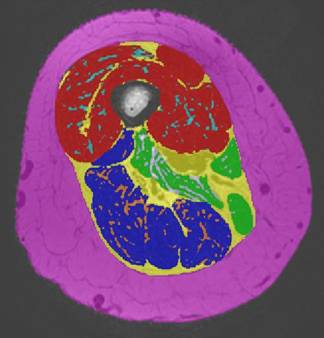Session Information
Session Type: Abstract Submissions (ACR)
Background/Purpose
Reduced quadriceps and hamstrings strength is a risk factor for knee osteoarthritis (OA). This strength loss is partly due to the loss of lean muscle mass, increased pain and neuromuscular inhibition. Intramuscular fat, or fat within a muscle belly, is related to poor physical performance and radiographic disease progression in OA. We investigated the relationship between intramuscular fat fraction and lean muscle volume of the quadriceps and hamstrings with isotonic knee extensor and flexor power in women with knee OA.
Methods
Women (n=20) with radiographic and symptomatic knee OA had the thigh of their most symptomatic knee imaged using 3.0T magnetic resonance imaging (MRI). The iterative decomposition of water and fat with echo asymmetry and least-squares estimation (IDEAL) sequence obtained 60 fat-separated images (3 mm slice thickness). Images were analyzed using SliceOmatic® software with a region-growing algorithm to quantify intramuscular fat and lean muscle tissue volumes (cm3) separately for the quadriceps and hamstrings (Figure 1). Intramuscular fat was represented as a fraction (%) of total muscle volume. Using a dynamometer, participants completed ten isotonic knee extensions and flexions, with resistance at 20% of maximum voluntary isometric contraction. Mean peak power (W or N×m/s) was calculated using the five highest contractions. Electromyography (EMG) measured the activation of the vastus lateralis and biceps femoris during contractions. Mean peak EMG amplitude was calculated from the five highest activations.
Results
Mean sample characteristics (±SD): age 65±5 yrs; Body Mass Index (BMI) 30±5 kg/m2. There was a positive relationship between quadriceps lean muscle volume and knee extensor power (B=0.634; p=0.004), controlling for vastus lateralis activation. Also, there was a positive relationship between hamstrings lean muscle volume and knee flexor power (B=1.173; p=0.010), controlling for biceps femoris activation. No relationships were found between quadriceps or hamstrings intramuscular fat fractions and isotonic knee extensor (B=4.351; p=0.764) or knee flexor (B=-4.793; p=0.645) power, respectively.
Conclusion
Lean muscle volume of the quadriceps and hamstrings, but not intramuscular fat fraction, were significant factors in the knee extensor and flexor powers of women with knee OA. Our findings suggest that the volume of thigh lean muscle is of primary importance in the physical performance of women with knee OA, independent of neuromuscular activation. Although intramuscular fat has been implicated in radiographic disease progression, its role in thigh strength and power is uncertain. Further investigation is needed of intramuscular fat and its relationship to other factors of physical performance, such as neuromuscular activation.

Figure 1. Red=quadriceps muscle, blue=hamstrings muscle, cyan=quadriceps intramuscular fat, orange=hamstrings intramuscular fat.
Disclosure:
M. J. Davison,
None;
M. R. Maly,
None;
K. A. Beattie,
None;
P. J. Keir,
None;
J. D. Adachi,
None.
« Back to 2014 ACR/ARHP Annual Meeting
ACR Meeting Abstracts - https://acrabstracts.org/abstract/the-relationship-of-quadriceps-and-hamstrings-intramuscular-fat-and-lean-muscle-with-power-in-women-with-knee-osteoarthritis/
